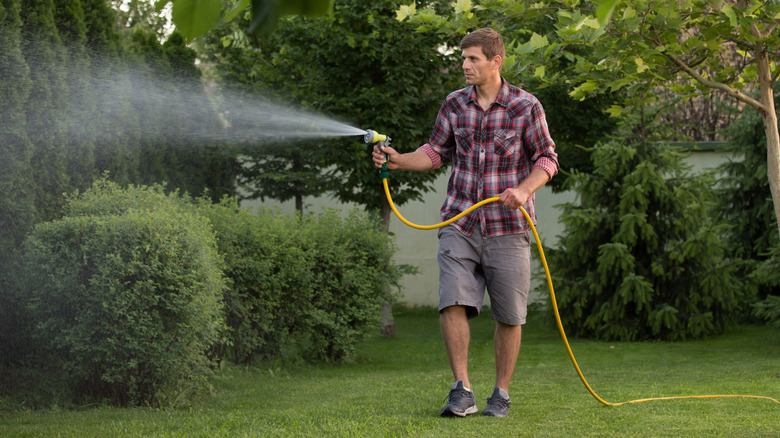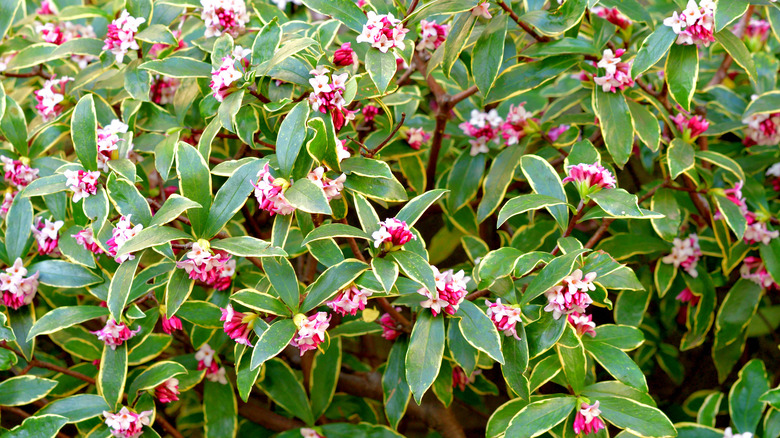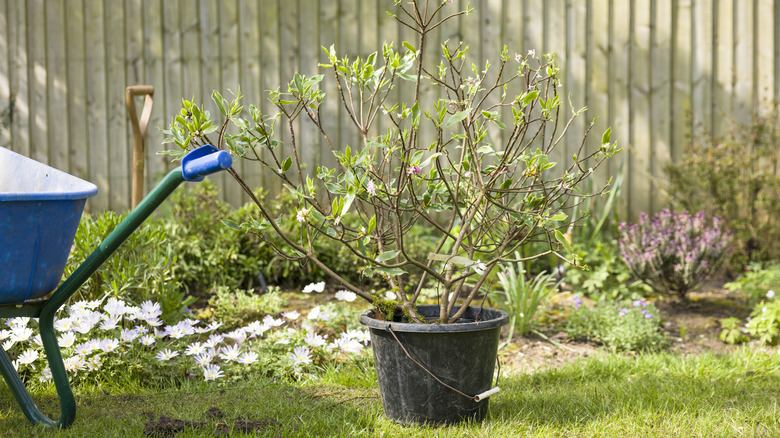The Citrusy-Smelling Flowering Shrub You'll Want To Keep Out Of The Garden
Shrubs play an important role in any flower garden or landscaped area, helping to provide shade, prevent erosion, and create visual interest with varying heights. There are also many fragrant flowering shrubs that will bring drama to your yard, such as daphnes. There are over 70 species of shrubs within the Daphne genus, offering plenty of variety for landscaping. These evergreen or semi-evergreen shrubs are popular because of their dense, dark green foliage that can also have variegated leaves. In spring, daphnes come to life with unique pink, white, or yellowish blooms that have an intriguing, sweet scent and are quite attractive to pollinators. Unfortunately, what is beneficial to bugs can still be toxic for humans and burdensome to the environment.
While there are plenty of positive aspects that may attract you to daphnes, you might want to think twice before growing one of these flowering shrubs in your yard. Here's what you need to know about growing some of the popular daphne shrubs, including the potential downsides to be cautious of and alternatives that might be safer to plant in your yard.
Daphnes are invasive and extremely toxic
However beautiful they may look in your garden, some types of daphnes can be a hindrance to their local environment. Daphne plants' native region is relatively widespread, spanning across Europe to Asia and down to Africa, but importing these shrubs into North America can present some problems. The spurge-laurel variety (Daphne laureola) is considered especially invasive. In the Pacific Northwest region, thriving in sun and shade, this shrub chokes out the delicate native undergrowth and rapidly takes over regions via its fruits, which are spread by birds. Additionally, daphne can alter the soil in these sensitive forests, inhibiting new growth of native plants.
Planting daphne shrubs doesn't just present a threat to local biodiversity; this is a red berry shrub you won't want in your garden if you have pets or children. Each variety has varying toxicity, but all daphne plants are poisonous to humans and animals. While the bark, twigs, leaves, and sap are poisonous, the berries that form after the shrub flowers contain the most toxins. Unfortunately, these brightly colored little berries can be very intriguing to children, who may want to pick them, but merely touching the plant can cause redness, itching, and blistering. Ingesting just a few berries can make humans and pets very sick, causing tongue swelling, drooling, stomach upset, vomiting, diarrhea, and lethargy. Eating 10-12 berries or more can even prove fatal.
Gardeners struggle to keep daphnes happy
Aside from the danger they may present to the environment and your family, shrubs in the Daphne genus are also notoriously tricky to grow. For one, daphnes are remarkably slow-growing. It can take nearly a decade for the plants to reach their full size, which isn't very large, usually less than 5 feet tall and 6 feet wide. Getting your plant to its full-grown size is challenging in and of itself. Daphnes tend to drop their leaves quite easily, and although they are considered to be evergreens, the leaves and branches they lose in winter are slow to grow back in spring. These surprisingly delicate shrubs also won't tolerate transplanting very well and are susceptible to root rot, scales, and aphids. Even if they do everything right, many gardeners complain about their daphne shrubs dying for no apparent reason.
If you decide that growing daphne isn't worth the risks, there are plenty of alternative evergreen shrubs to make your landscaping look great all year. Some suitable native and non-toxic shrub varieties include chokeberry, blueberry, wax myrtle, American hazelnut, and Texas sage. With native plants, you'll not only support natural biodiversity but also have to put in much less effort for the plant to thrive in your garden.


